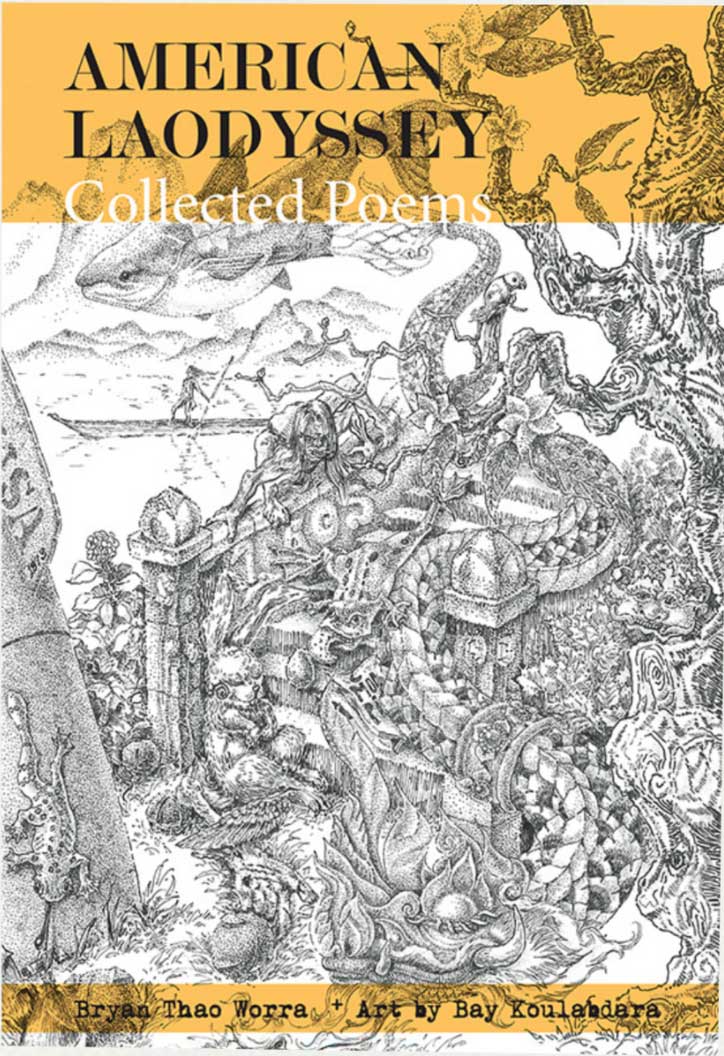A Fireside Chat With The Creators Of ‘The American Laodyssey,’ Bryan Thao Worra And Bay Koulabdara
By Legacies of War
We found out about the BIG NEWS about this book on Bay’s Instagram. Tell us about this exciting project and partnership between you (Bryan Thao Worra), Bay Koulabdara, and Sahtu Press!
Bryan: This is the very first time that all three of us have collaborated together, but we’ve been long-time fans of each other’s work. As Sahtu Press enters its tenth anniversary, it’s been a big learning experience with a lot of growth. We wanted to make sure there’s a way for many of our Lao artists to see their work collected in a book, and for readers to have a sense of what the Lao imagination looks like in both the written and visual form. American Laodyssey is a bit of a road trip across space and time, history and myth, from the edges of Vientiane to the distant galaxies where Lao reach the stars in at least one timeline. It touches on our ongoing concern with UXO and how we heal, and what legacies we build for the next generation as we search for home.
Bryan, for those who aren’t familiar with your poetry, please share with us a bit about your work and journey to this project. How does your identity as a Lao American come through in your writing?
Bryan: I was born in 1973, just a few months before the end of Operation Barrel Roll and the U.S. secret bombing of Laos, among other historic events for our community. Adopted by an American pilot flying for Royal Air Lao, I initially didn’t have much contact with other Lao for nearly 20 years living across different parts of the U.S. such as Alaska, Montana, and Michigan.
Poetry became a way of exploring my personal history and the collective history of Laos. This was needed because of often very large gaps and mysteries about what happened so many years ago, and who we were becoming. Some things will never be known, and of what we do know, some things should be questioned and re-examined with great curiosity, an open mind, and a compassionate heart.
At 30, I was reunited with my long-lost family and this year marks the 20th anniversary of that return to Laos. Going back to Laos fundamentally transformed my writing from that point forward, especially on issues such as unexploded ordnance and its long-term consequences for our people. What deeper lessons could we learn from that experience, how could we help others, what should our relationships to one another look like in our journey? Novels, movies, memoirs, and music weren’t really providing me clear answers for that, and so I turned to poetry. And the rest, as they say, was history.
Bay, how has your sense of identity influenced your art?
Bay: My goal is to let my illustrations show the influences that an odyssey has on a person and their art. Earlier in my journey as an artist, when I was just a teen, I didn’t have much of an interest in Lao or Southeast Asian art. I think it was partly because it’s a tradition that was not taught in American public schools. In my middle school and high school days, “Asian” art was always Chinese and Japanese. I really took interest in Japanese art and culture, then as I got older I dug deeper into Japanese art and artists and their influences. I realized that Japanese art and culture were influenced by Buddhists who traveled from South and Southeast Asia. That then piqued my interests in Lao, Thai, and Cambodian art and architecture. I slowly started exploring the artistic expressions and motifs seen in the paintings, drawings, and architecture. I knew I did not want to simply copy the motifs; I didn’t want to make bad copies. Instead, I wanted to borrow the rhythm and patterns to make my illustrations better.
This book, after all, is The American Laodyssey. When I think of an odyssey, I think of a long and adventurous journey where all of our senses pick up and remember people and things from the adventure. Because I’ve met wonderful people and seen so many wonderful things on my own journey, I wanted the influences from the people and the places to shine through because they’ve all made my art and illustrations better.
Tell us a bit about the preview illustrations that you’re sharing with our readers!
Bay: The three that I am sharing here show a range of influences. The fish is called a black crappie (Pomoxis Nigromaculatus). It may or may not end up in the book. I’m sharing this because that is my “normal” style of illustration. It is a scientific illustration style. My scientific illustrations are heavily influenced by Western and European drawing styles, which is not surprising because I attended art school in the U.S. before entering architecture school at The Ohio State University. I do think that when I worked on the scales, I may have allowed the Lao art influences to peek through a little.
The stilt house is a “copy from memory.” It’s a drawing I did from memory of a drawing that I found in my family’s home in Laos when I was a child. That drawing may have been the initial influence that pushed me into getting into architecture. I did this during the holiday season in 2022, it was a spontaneous reflex to want to draw this, but in the western pen and ink Style. I just allowed the memories of the original drawing and of Laos to flood back and end up on the page of this drawing. I’ve always wanted to document the houses in Laos. This illustration may eventually push me to do a project of documenting Lao home styles.
The cover art is a culmination of the stylistic influences from Western art style as well as Lao motifs and subject matter. The subject and styles were selected specifically for The American Laodyssey project. We see Lao motifs like the plumeria flowers (“Dok Jumpa”), the naga, lotus flower, etc. Western subject matters include the cluster bomb casing and bombies, they were included in the illustration to commemorate the 50th anniversary of the end of the American Secret War in Laos. I chose to use dots (a style known as stippling) on the cluster bomb casings as a reminder to readers of the numerous bombies littering the land in Laos. As the reader studies the cover art, they may find quirky and terrifying subjects and perhaps they may be moved to reflect on their own journey and odyssey.
When should folks expect the release of this book? Is there a way to pre-order?
Bryan: We’re looking towards an autumn 2023 release, and a link will soon be available at Sahtu Press at: https://sahtu.press/books/american-laodyssey
Images courtesy Sahtu Press.














